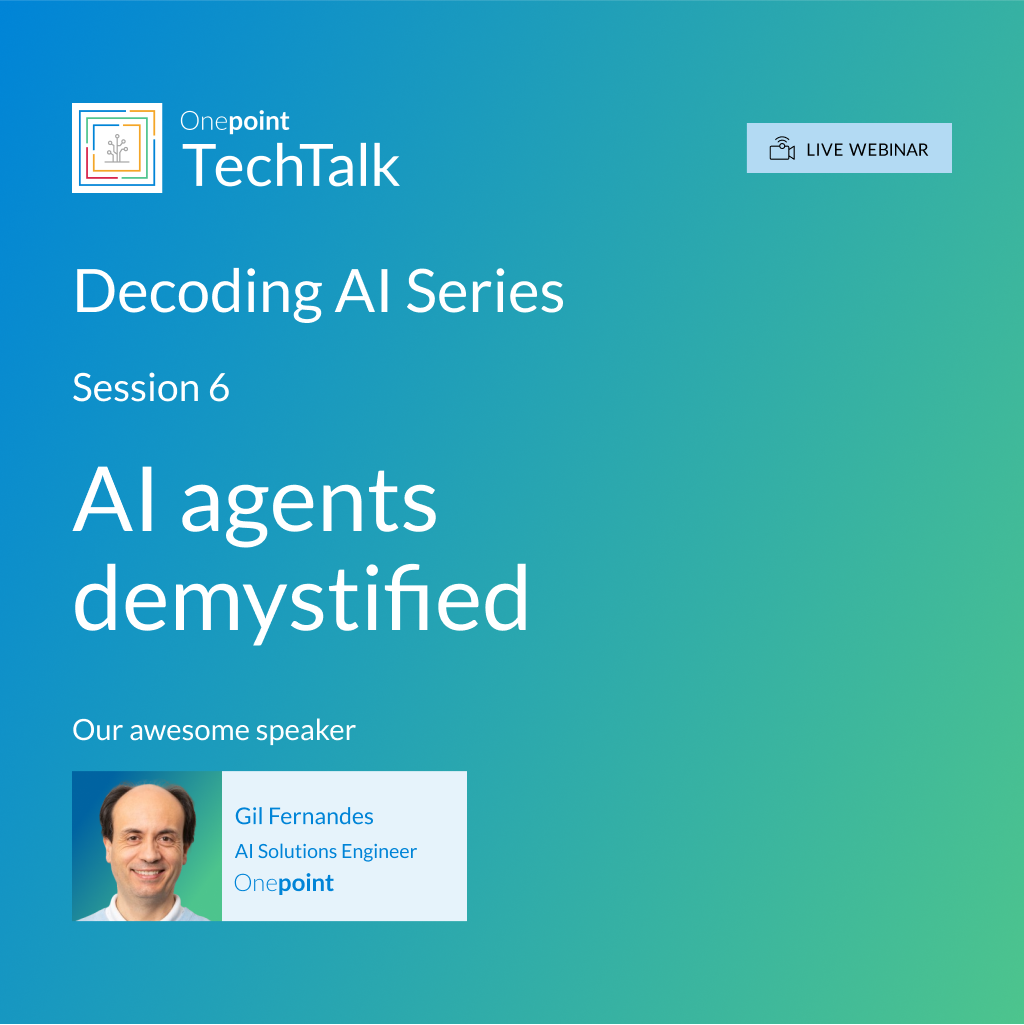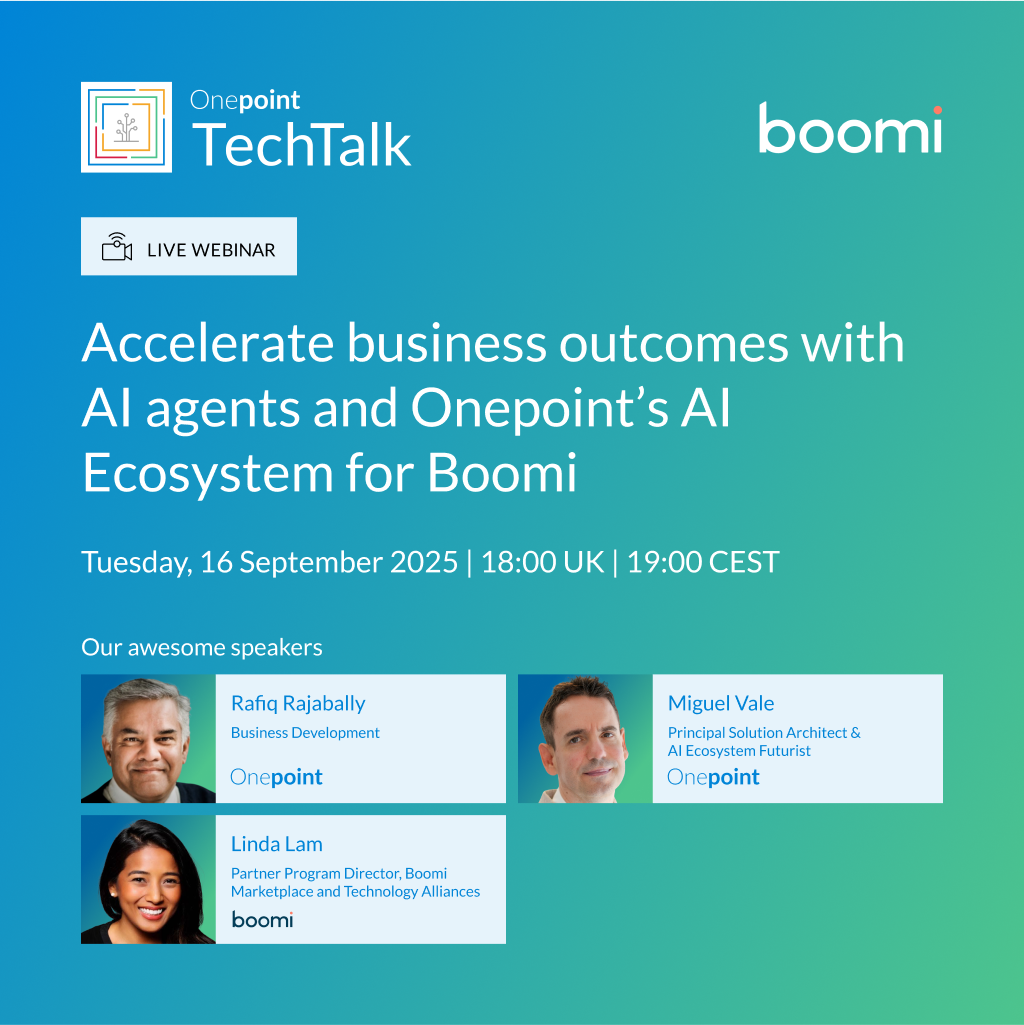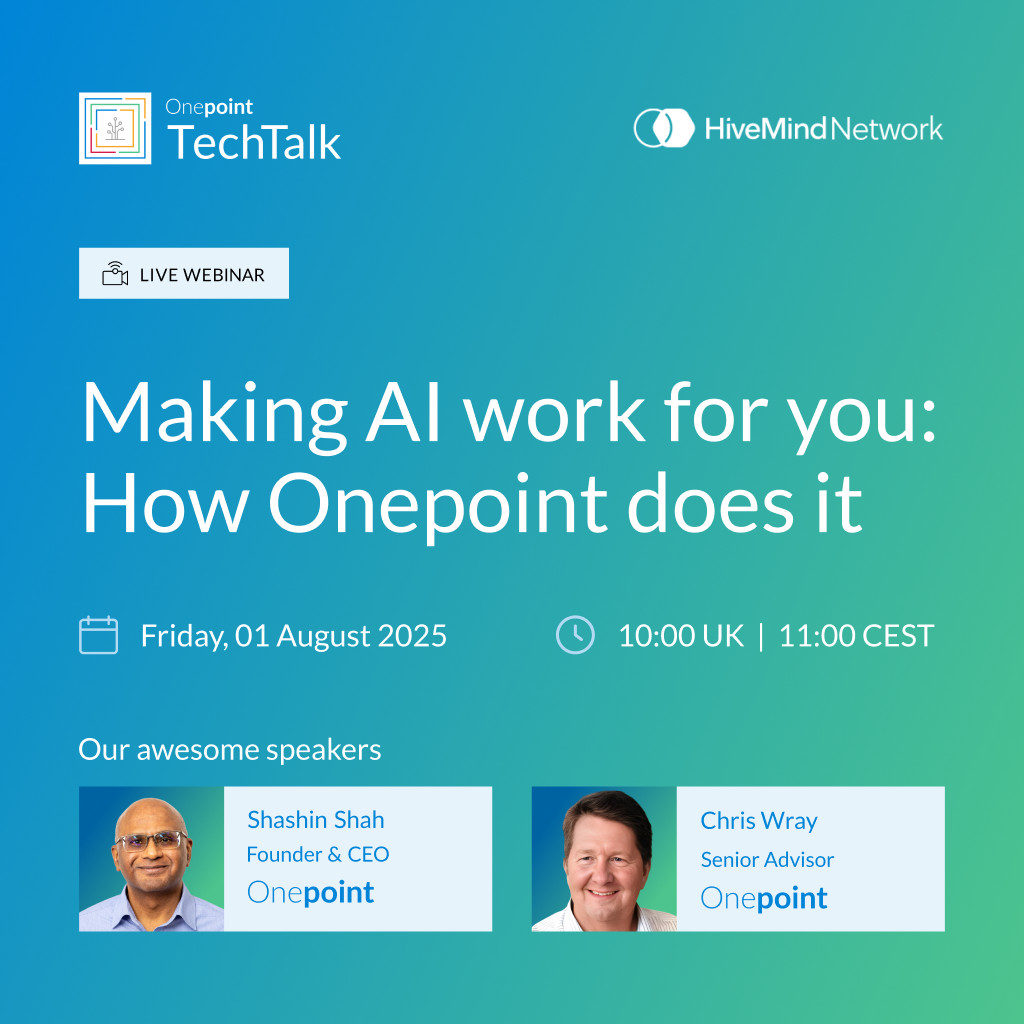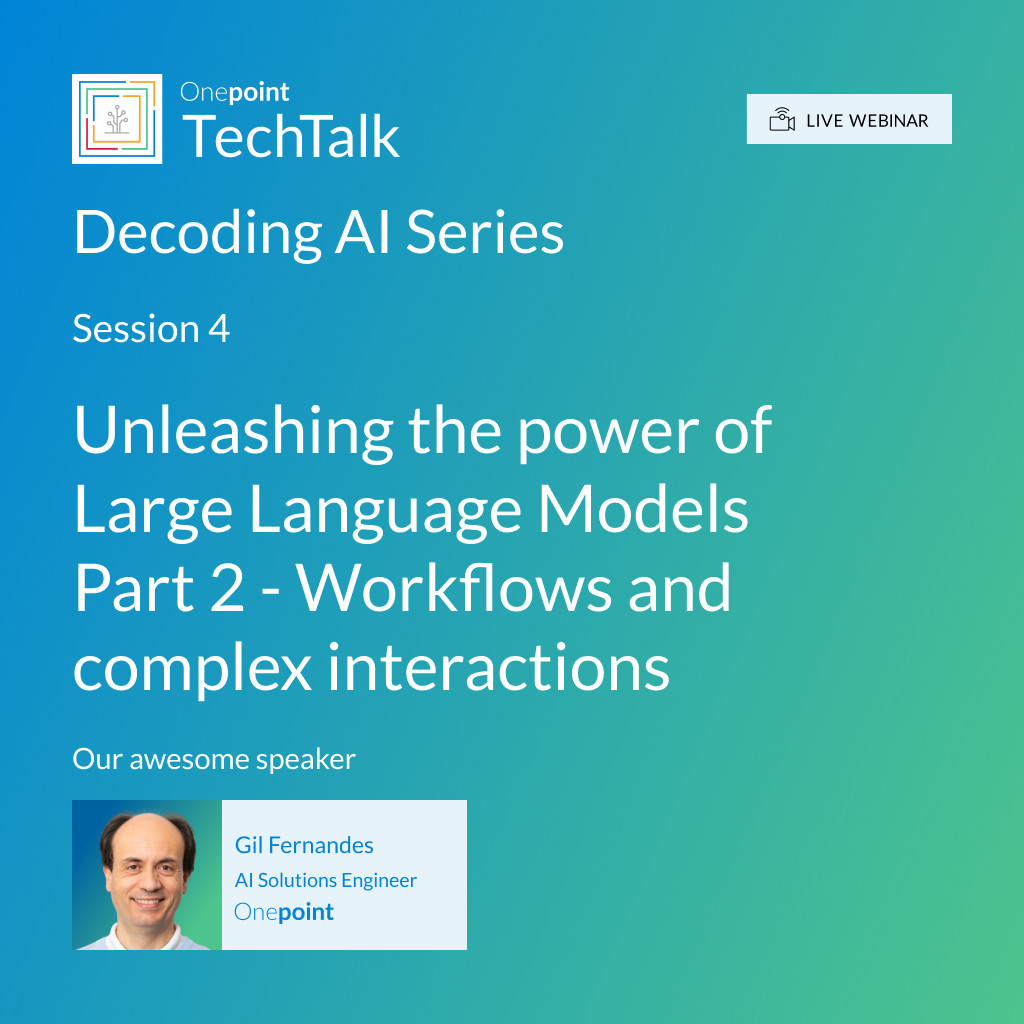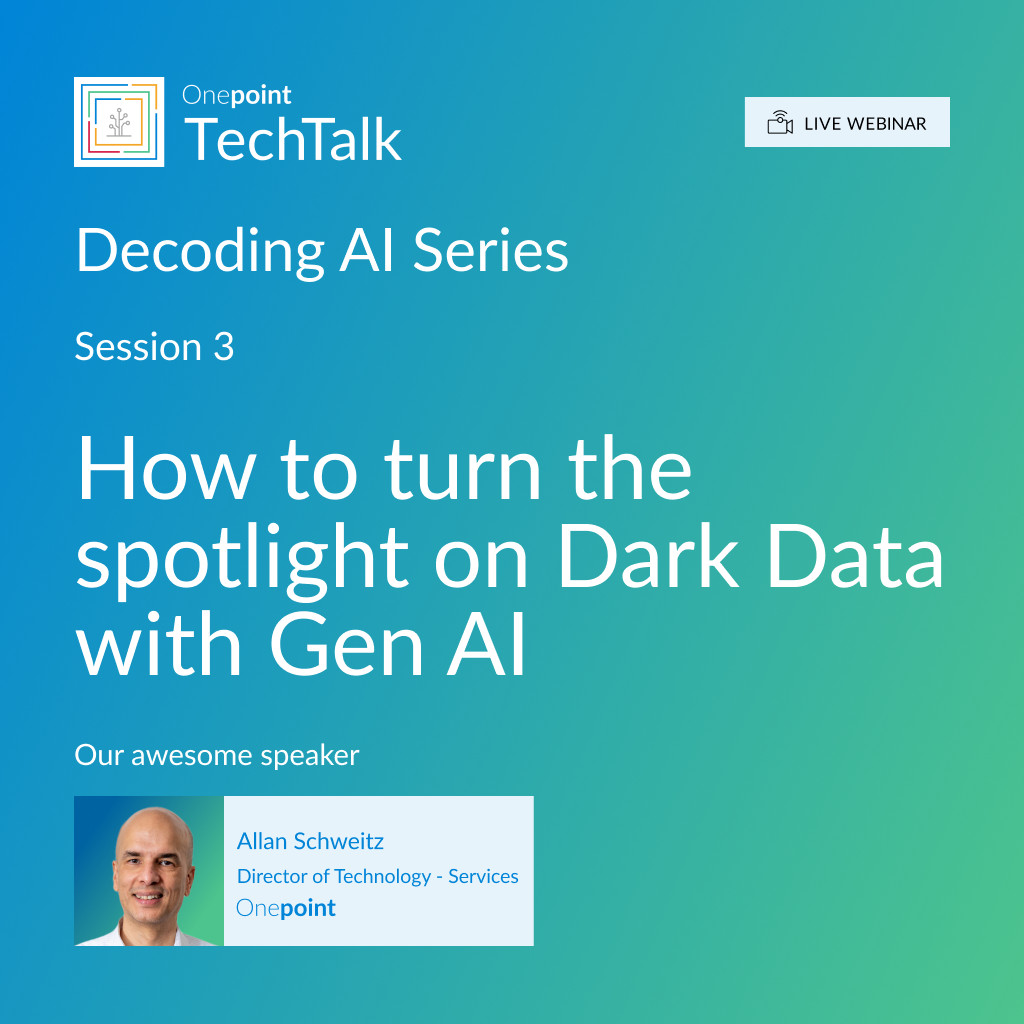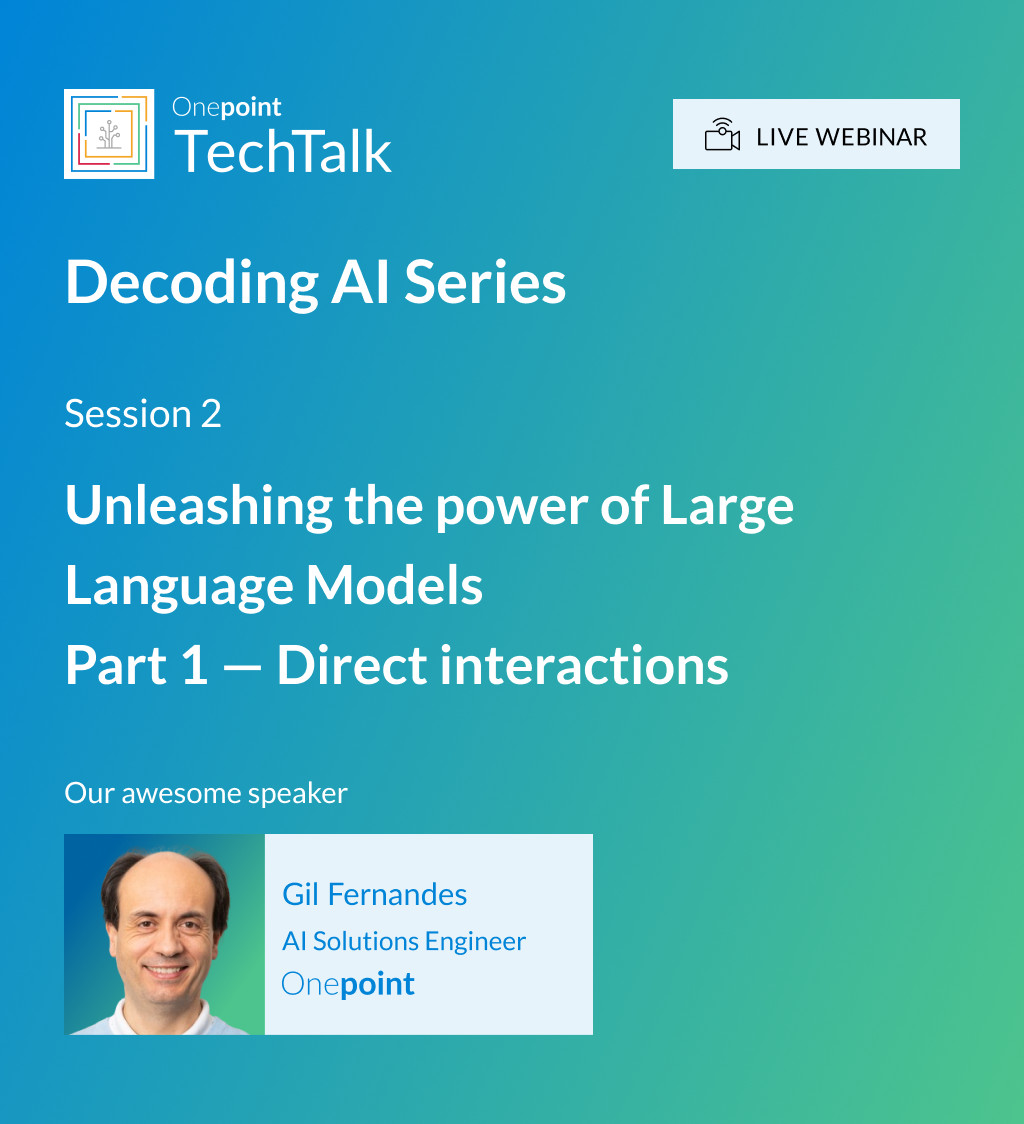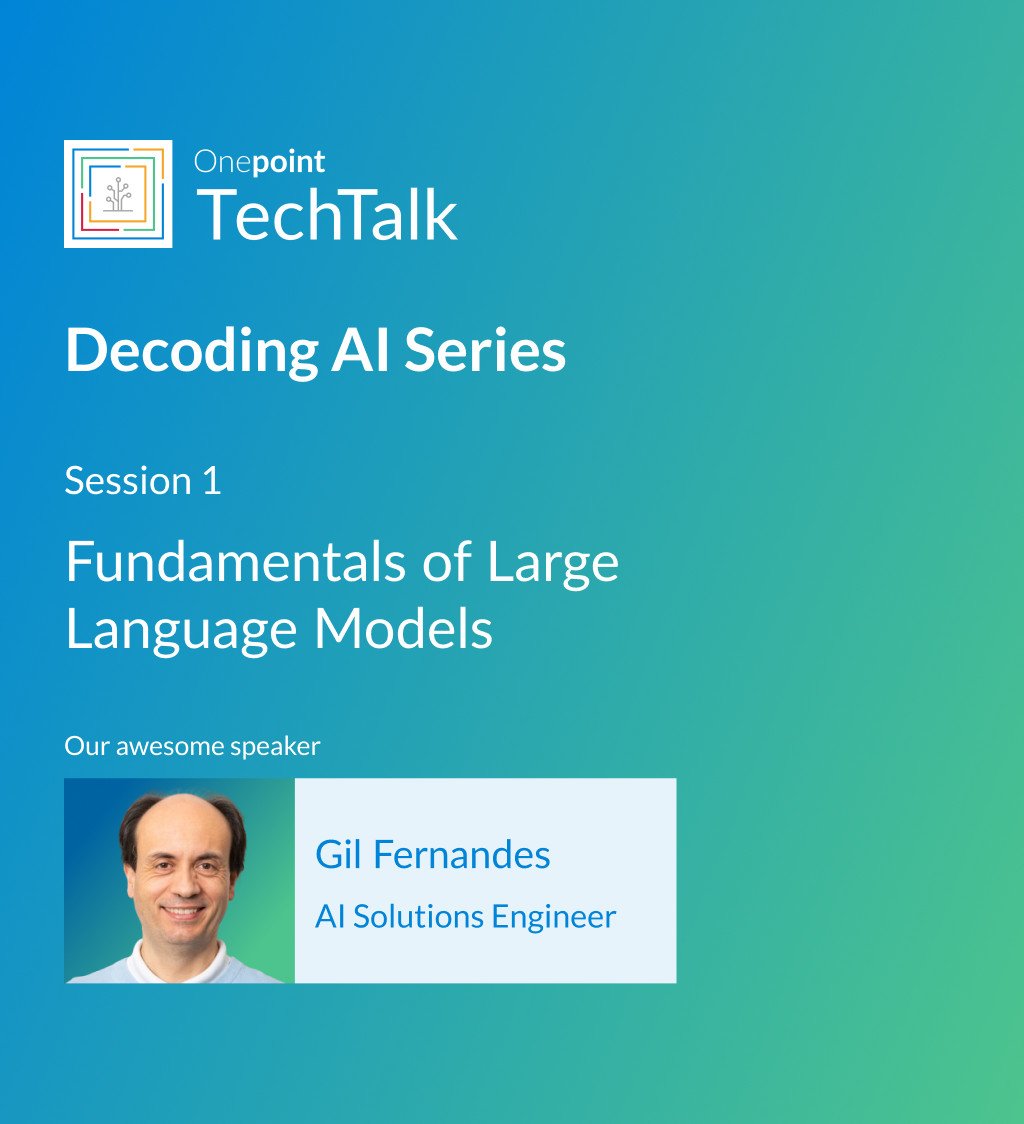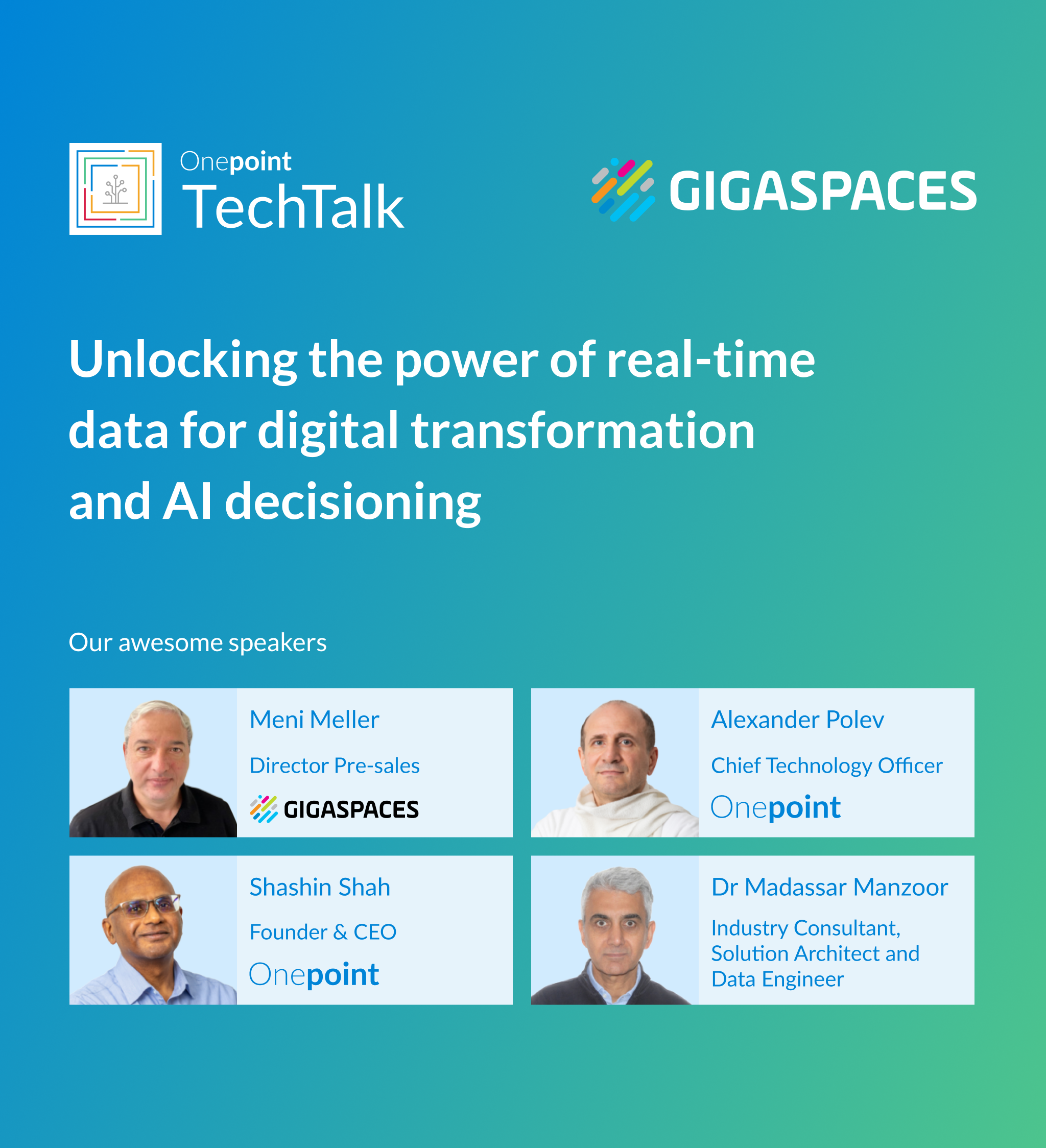Making AI work for you: How Onepoint does it
AI is transforming the way enterprises operate. But are you harnessing its full potential? In this session, Shashin Shah and Chris Wray give a glimpse into how Onepoint applies AI for business use cases to create value for our clients and ourselves.

This event was livestreamed and recorded
What you'll learn
- Making AI work: While most AI conversations dwell on possibilities, this session dives into practical outcomes. Learn how AI can streamline operations, reducing costs and enhancing efficiency. We unpack Onepoint’s proven approach to applying AI with a sharp focus on business value, not just the tech.
- AI offerings to turn ideas into reality: Discover how Onepoint’s AI Expert services and AI Co-Lab turn ideas into scalable solutions. Witness how our pre-built series of AI Apps and the engine that underpins them help clients to adopt AI faster without starting from scratch.
- Real-world applications: Explore how AI can be applied to diverse domains through practical use cases. Get an inside look at how our Data Wellness tool (Onepoint D-Well™) uses AI to assess and improve enterprise data management and the Responsible AI tool (Onepoint Res-AI™), curated with expert knowledge.
- Future implications: Learn how to move confidently from legacy ways of working to AI-ready frameworks. Walk away with the practical insights on implementing AI responsibly and how to prepare your organisation for the next wave of AI innovation.
Featured speakers
Who is this for
This session is ideal for business leaders, non-technical staff, AI and data specialists, and technology leaders looking to maximise the potential of AI and unlock real value. Business leaders and decision makers will also benefit from the discussion in driving innovation with AI.
Materials from this webinar
Presentation
Transcript
Si Sultan
We’ve got a little bit of a new platform to contend with, hopefully, fingers crossed. The technology will be with us today and working with us. If not then, then please do indulge us. Give us some leeway on that. If everybody while Shashin and Chris are talking this morning, if everybody can mute what they from their side, we’ll have it. We’ll have time for a Q&A session at the end. And I would ask please that you hold your questions, because there’s a lot of material to cover, and I don’t want to steal their thunder. So I will hand over to Shashin now and put myself on mute. Shashin.
Shashin Shah
Thank you Si. Good morning everybody, and thank you for giving us this opportunity to share some of our learnings and experiences in applying AI, both internally within the organisation, but also for some of our clients. So this morning, basically it’s myself and Chris Wray who will actually be doing a joint presentation. So what is it that we want to cover? Just a very high level I’ll explain in detail exactly what we’re covering today. We’ll give you just a brief information on the company. We’ll then talk a little bit about AI in terms of what we’ve been doing, and also sort of present our strategy and explanation of some of our services. But the majority of the time, frankly, is going to be spent on trying to show you some demos, which brings out the learnings from AI and application of AI to some real life problems. So we’ll spend the bulk of the time on that. We’ll then talk a little bit about some of our offerings and how we’re taking that to the market for some of our clients, and then, of course, question and answer session towards the end of this. So in terms of what what we covering today, really, Chris and I will give you an overview of how we are applying AI for business use cases to create real value for our clients and ourselves. We’ll walk through and demo a series of examples. We want to avoid death by PowerPoint. So we’ll jump into some live demos. And I hope the demos will cooperate. They always have a tendency to do their own thing during live demos. And these are some of the things we actually want to try and present. In a sense, it’s based on some real world tools, architectures and frameworks we’re using. We’re actually looking at how to apply AI to solve legacy issues, and, of course, have architectures that can deliver measurable outcomes and then unlock the true business value of AI. This is not going to be a technology focused session, it’s more a business use-related session. So just very briefly about the company, just so that you have a little bit of context as to where we come from. So Onepoint is an award winning architecture led boutique consulting service, delivering solutions powered by AI. So we have a top tier, recognisable brand name clients like the TUI Group, Vision Express, Moto Hospitality. And typically, we tend to deliver enterprise grade solutions with a personal touch, being a boutique consulting company. This is our 20th year of business, and so we basically, apart from carrying out our business, we are deeply entrenched in delivering social value through some of our initiatives, for charities and for anyone interested in meditation sessions, you can log on to our website and see how we conduct free meditation sessions every Friday. And of course, as being a small boutique consulting company, we have to be on the edge of innovation, and today, we will be sharing some of our work in experimentation with AI and how to deliver value to clients. And I’m now going to ask my colleague Chris to expand a little bit about the approach we’ve taken to actually experimentation of AI solutions. And Chris over to you.
Chris Wray
Thanks, Shashin, so this diagram really summarises our approach. We’ve taken a very proving internally that solutions work for us by applying the technology to our own situations and driven by business benefits we can achieve, we then look for partners to work with who may have channel capability, but also specific domain expertise to add to our technology offerings. And then having developed those, and you’ll see that through quite a few of the examples today, we’re then looking to drive those forward into impact driven and commercial models. And we’re very flexible on how that might might operate. So in terms of the types of work we undertake, the next slide articulates the broad service types. So we offer expert services, which essentially are the classic consulting strategy, and helping you with AI and taking you all through solution and technical architectures to basically make sure you’re optimising that, including a managed services offering, we also work in a collaborative way with clients, essentially creating proof of concepts using technology, choosing the best software and getting proof points in place within two to four weeks using a value path and strategy approach. And then lastly, we have our AI apps, which is most of what you’re going to see today. So these are tools and smart advisors built on our AI engine platform, which is continuing to expand and have more features and added to it as we see more opportunities in the market. So those three distinctive approaches, I’m going to show you five different demos today, and we’re going to start with our first one, which is the Data Wellness tool. So this is a scenario which could be deployed by a data consultant or by a client to understand what are the key issues with regards to their data best practices and benchmarking them against what might be needed. Its objective is to really reduce down the time required to understand the scope and focus of a consulting engagement. So Shashin, if you can burst up the data wellness demo. So what you’ll see here is the home page for the tool itself. And there’s a few things I want to draw out from this and on all these tools, I’m going to draw out both what the tool does, but also try and explain how we’ve used AI and large language models to achieve this, because I think that’s really the innovative and interesting thing. So we’ve done three different things in this tool. The first thing is, we have a reversed chat bot so that so the tool asks you the questions, as opposed to you thinking, you know the questions to ask, which creates a very educational and interesting approach. The second is we’ve developed an ontology or knowledge framework, which are the eight boxes to summarise the major issues involved in each of involved in Data Management. Those two things together. Plus we have a confidence calculator, which is this little indicator on the right. So we continue using the tool until we get sufficient information and context to know that we can give a good answer. So for those familiar with all the challenges of prompt engineering and LLMs, that’s making sure we’ve got a really good, sophisticated prompt before we run the query. So in this scenario, we’re going to imagine that the client has come on here. They want to work out broadly what they need to do about their data ecosystem, and their biggest concern is poor data quality. So Shashin will click on poor data quality as the option in this scenario, the inquiry logic at the top, which goes through specific aspects and generate the questions. That’s all generated by the LLM tool. But critically, in this situation, all the data and knowledge which drives this tool is proprietary to Onepoint. We do not go out on the web, and the tool is designed to have proprietary data sources in it, so having understood that data quality is the issue, the next question is, what specific aspects? So let’s imagine we’re struggling with the accuracy of data and also completeness those first two so Shashin will go to the next level. You’ll see at this point we also have the option if we wish to to not only choose from the suggested options, but also put in free text for the purpose of today, we won’t do that, but that is an option. You can go straight in if you’re an expert, IT user. So in this scenario, we’re driving into the root causes of data quality, and we’re going to say that we rely on manual checks. And the third one, Shashin, please. We’re not actively involved in addressing these issues at the moment, because we’ve got resource issues, a common problem. So at this stage, you’ll see the smiley face on the right has started to become a bit happier. It’s not quite got to the point where it can produce the report, but it’s getting there. So having understood the nature of the issue, we’re now getting into what are the main challenges you face on manual checks and end user feedback. So the manual checks are time consuming. Yes, definitely the first one and the second one, end user feedback is inconsistent. So what’s happening here is the LLM tool is creating a unique question, and it’s also populating the answers uniquely as well. This is not predetermined. This is not linear. This is totally emergent in its inquiry approach and in the data and content it’s using. So now we’re getting to how do we prioritise data quality issues? Well, the next well, we think we do prioritise, not based on business operations. That will be the first answer and end users, because they tell them those two I think would be a good scenario. So we’re getting into the last stage of the question in terms of, what do we do today to manage and improve data quality? So we’re going to suggest, in this scenario that we probably use a spreadsheet number one, and I think we use number three. We use some scripts, but we’re pretty limited on our technical skills. So at this point, you’ll see that we’re getting pretty much into the detail, and the confidence indicator has now generated the fact that it’s smiling, and we can actually generate a report. So this point we will generate a report. So in literally less than I started at 10 past, in less than two to three minutes, we’ve gone from a very unknown understanding about the clients data issues and what they’re doing to a very refined clarification on the issue. Some topics are out of scope, some are in and we’ve begun to understand what the client themselves do with regards to actions. So what we now have is a high level diagnostic report. So we have suggested courses of action which have been generated from the exercise. So guidance on a data quality management tool, prioritisation framework and quality training. For example, those of you familiar with data management will recognise a lot of these actions. The report also then highlights what to avoid, which are critical risk issues, and also highlights the benefits that can be achieved. Now, for the purposes of this exercise, the other one I want to highlight is the confidence degree. So the report also explains the rationale and logic for why it’s come to this conclusion. And interestingly, in the second half of this description, it says, okay, whilst the customer is using spreadsheet tools and scripts indicating some background on technology, there’s limited information about the data, governance strategies and their prioritisation processes, informal and resource constrained. So it’s giving you really good insight into what next to go into in terms of the approach to take. So overall, at this point, one can see a knowledge graph, one can send a report, and one can also download a PDF. Interestingly, also you’ll now I’m going to ask Shashin to suggest a consultant. This is a bit of an intro, intro to the demo we’re going to do later. But this now takes the context of the problem and the data issues, and it maps them using AI against the inventory of consultants that we have within Onepoint, and it will generate not just an indication of who’s the best consultant to solve that issue, but it will also create a custom explanation as to why in this scenario, Gil Fernandes has come up as very suitable because he has the software engineering skills to do, to deal with the custom scripts. He’s very used to Talend and Java based projects. So it’s done the thinking for us. It’s not done a classic Google point search. It’s done a semantic search driven by AI and LLMs. So that is the Data Wellness tool.
Now what I’d like to now do is move to the Responsible AI tool. This is a similar user interface, exactly the same design to the tool, but a different domain. This is to help someone understand the client’s responsible AI issues. Now we’re not going to go through the tool as I did the previous one, because I think one would all probably understand what’s happening here. But I want to draw out the fact that this tool is different. This tool, we curated the content from outside of Onepoint, working with a third party consultant, Tuli Faas, who’s an expert lawyer on data, IP and ethics, with SITA, large technology infrastructure provider to the travel industry. And this tool has been created from curating the knowledge that’s available on responsible AI and creating our own ontology framework the eight boxes. What we’re able to do now having built this tool is we’ve underpinned it with an AI engine so we can create a version of this tool for any domain or content. We can flex it for the number of boxes that might be shown. We can vary the confidence level on the inquiry happy face, and we can add different features and functions and map it different consultants. So this could be quite interesting as an example for either what Hivemind itself might choose to have for diagnostics on high design or high change or high tech, or potentially individually, as consultants, there might be merit in having a version of this for your particular area of expertise. So that’s something we’re able to do incredibly quickly now, with the power of the of the AI engine.
What I’ll now move to is the next demo, which is our Expert Matcher. So this is a more sophisticated version of the consulting matching tool that we saw before. This is actually an alpha version that’s being built for a major law firm for Tansey, which has about 250 consultants. And the difficulty often is finding the right consultant for the right piece of specialist work that can be internally in the organisation, or potentially could be externally with a client accessing the website and looking through CVs and trying to find out who’s relevant. This tool, very interestingly, uses the LinkedIn profiles extracted and then uses a matching approach, similar to the data wellness and responsible AI tools, to get to a good conclusion as to who the best consultant might be. So we’ll walk through this with an example. So let’s imagine I’m looking for a lawyer to help with a major M&A corporate transaction in financial services. So I’m going to go on here, which industry am I seeking expertise in? Well, I’m seeking expertise in financial services, which says there’s 77 consultants in that. It’s then taking me through the question as to where do I want those consultants based from? So I’m going to choose London. But what I like to stress here is this is not a defined database structure. These choices have emerged from all the information that’s in the data set. There’s nothing else other than these offices, because that’s all that exists. I’m then going to decide, because it’s a major corporate transaction, I want pretty large scale, maybe a 200 to 500 employee experience. But actually, I don’t mind the 51 to 200 as well, but it’s got to be larger than 50. So please click the those two. Shashin, that’s great. So at this point, I’m I’ve now understood that the location, depth of expertise, I do want someone who’s pretty experienced for such a transaction, so I’m going to go with the 10 plus year option of six consultants, please. There we go, and on to the next option, and then, in terms of the type of job title, well, I want somebody who’s pretty senior, so I’m going to go for a legal director, and also the partner option as well, please. Thank you. What’s happens now is having gone through the matching the tool now flips to being a ranking and criteria tool where it’s looking at the data sets that exist within those consultants, and it’s actually drawing out the queries from that set of consultants that we’ve chosen. So this screen looks very different every time you run it. So what areas of legal practice do I want? Well, I definitely want corporate law, and I’d like some employment law, because there’s a lot of people involved. I definitely want real estate services, because there’s some organisation there’s some buildings involved, and I would like those that are ranked in the legal 500 so I’m going to click on Alistair Keith and Claire Holland. I do want international transactions, and I do want mergers and acquisitions, as I’ve said, which is the yes to that question on the next one down, Shashin, that’s it. So at this point, what you can now see, if we scroll down is Alistair Keith clearly comes up as winning the ranking game, as opposed to his colleagues Claire and Ken. What’s on here, as well as the actual link to their LinkedIn profile is a customised CV which is tailored from the content to the requirements of the client, as opposed to a static CV. So some very interesting ways in which AI and LLMs can drive far more value here in the B2B world, right? That’s great. We’ve concluded on Expert Matcher.
We’re now going to explain a little bit of the work we do in our Boomi services. So as well as the agents that we provide internally, we also work for a alongside a major partner, which is Boomi, which some of you may have heard of on the tech technology background. They’re the top quadrant Gartner provider of essentially data management software, particularly focused on collaboration and connectivity. So their biggest challenge is trying to get their platform to work with lots of other ERP and other vendors and cloud environments. And what we’ve developed for them recently is 40 agents and connectors, which is Shashin, scrolls through this list, you’ll see that these are all efficiency orientated around data management. There’s a lot of things around scheduling and data quality. Further down, there’s more business orientated ones around hotel matches. These are a good example now as to what is available in the marketplace as agents and connectors, and the Boomi environmental Marketplace is a great one to go and look for in terms of ideas and guidance as to what may be possible. We’ll now move to the last type of demo. We’re going to do our explanation, which will be covering our work with a recent brand and merchandising business. So a little bit of background, because this may be probably the most relevant to sort of the core consulting activity of trying to improve operational activities in a business. So this business, BrandWorksCo provides a very interesting role in that it customises merchandise to be able to then offer that to clients who may buy it in hotels or events or exhibitions. So the challenge is to very quickly customise a design, very quickly sign that off with a client, be able to manufacture it, often remotely in China, in 10s or 20 1000s of volumes, and then ship that very efficiently to very different destinations. The difficulty was they were all starting with essentially old fashioned or spreadsheet approach and very disjointed systems. So the first thing we did was to get them onto a core, Quickbase platform with support from some other solutions, elements like Xero and Zapier, and having that core data in place meant that we were then able to deploy a range of AI agents. So two examples. One is that they used to use their freight forwarding was very complicated. They’d have to send five or six emails out to different freight forwarders. They’d have to ask the quotes back. They came back in different layouts. Often the quotes didn’t have the quantity or the weight or different currency scenarios. They had to choose from all that. They had to wait till they’d arrived, and then they had to choose the best from a cost perspective. Often that process used to take two to three weeks and an awful lot of manual intervention and oversight. Today, they now use an email AI agent. So that agent takes the outputs of what the requirement is. It creates a customised email with the quantities, the weights, the location of the client. It asks for a quotation in a certain format, and then, interestingly, waits for the responses. And then, if it doesn’t have a response in a certain time period, the agent automatically requests a follow up email. Eventually, when the responses are in, it produces automatically a assessment of the different offers. It suggests the best one, and then it sends that to the human in the loop to actually conclude, yes, we do want to ask this freight forwarder to deliver the merchandise. That request goes out again, then on the email agent, and that agent oversees that process until that whole delivery has concluded that has had a huge impact on reducing the time, and as you can and cost, involvement of individuals in that. And you can see this example above, the order generation time which was to agree the spec with the client, has gone down now from three days to 20 minutes, and this has meant that a not a large organisation, can now achieve 10, 15, 20 times far more volume with no lost revenue using agents in a very, more, very powerful way. So the message really, from going through these examples is it’s an incredibly exciting time, I think, for everyone who’s got an opportunity to create business ideas, take them to clients and get technology deployed. I’ve gone through a range of different areas. We’ve covered the smart advisors with data wellness and responsible AI. We’ve talked a little bit about how the Expert Matcher could work. And then we’ve gone through more custom examples with regards to Boomi and also this BrandWorks example, I think it’d be very interesting to explore, maybe in the questions how some of these use cases could be deployed, either individually by yourselves or possibly more widely in the Hivemind network. I’ll now hand back to Shashin to give an overview of Onepoint services. Thank you.
Shashin Shah
Thank you, Chris. So really, in terms of our service offerings, just at a very high level, there’s a range of consulting services around AI helping clients with discovering the right use cases for which to pilot and then build a prototype for that AI use case, and then turning it into a proper AI app, launching it, and, of course, ensuring that you can deploy and scale it and manage it over time, because this is a very fast changing environment, and so management and incorporation of new features is a constant theme that one needs to work on. On the right hand side, it’s more about taking your idea all the way from concept to a pilot stage and then actually implementing it back into the business. And that’s where the Co-Lab type facility, where we work very closely with our clients, and we look forward to hearing any specific use cases that may be applicable to Hivemind network. Chris has outlined some of those things, and really very much open to actually hearing what comments people have. I’m sure we’ll get into the question and answer in a moment, but happy to set up a discovery call discuss any specific challenges. And these are the people you can reach out to. My Details and Chris’s details are on the screen. And my colleague, Suresh, is not on the webinar, but you can reach out to him as well. So really, that actually at a high level, is what we wanted to present. And can try and hand back over to by the way, if you want access to the D-Well tool to be able to play with it, or even the RSesponsible AI, you can contact contact me or Chris, or you can register through the website, and those are available for you to pilot if you want to. There’s no cost. These are free tools. And then the expert matcher is something we’re trying to deploy also in the next few weeks. So with that, I’m going to hand over back to Si to see how to progress the rest of the session.
Si Sultan
Thank you very much. That very, very interesting. I do have some questions, if you don’t mind, to both of you. So the first question that I have is, when you’re doing the assessments with clients, do they navigate the tools, or do you sit with them and navigate and ask them questions and then fill out the answers that they give you. Or how does that work?
Chris Wray
Yeah, so it can be used in different ways. Si, so ideally, we would like the clients to use the tool themselves, if we, if they, if they’re confident enough to do that, and it’s a very efficient use of it. However, we have also had the scenario where we might use them in a workshop alongside the team to decide what the scenarios are jointly. It also raises very interestingly, because the tools are self seeking. You know, if you compare it to what a linear question areas where you sort of have fixed answers, it’s really good where you’ve got a group of individuals involved, which often is the case with something like data, there might be the core IT department, maybe a Data Officer of some description, some business users, but the really beneficial thing is actually to get each of them to complete the tool themselves. And then we’re now using AI to transcribe those answers into a combined version, and then suddenly, what that means is you’ve got the sort of consensus view as to what the core issues are. If you’re running a workshop or using some sort of consulting activity, I think you’ve got to make the judgement as to is the client happy and able to do it themselves. But often they find it really very beneficial and educational, because particularly on the responsible AI, one, which is quite a complex topic, people often don’t want to be exposed to going through some of those things on complex terms around transparency and equality and bias, whereas actually completing that on their own slowly can be really educational and informative, and sometimes we’ve found people go through the tools two or three times and almost click areas which they think they know a lot about, but actually they end up learning a bit more as they go through the tools from a training perspective.
Si Sultan
And do they so I imagine that there are some clients for whom the data is quite sensitive. So how do you answer the concerns? I guess, when they say, is my data going to be folded into the larger LLM and is it going to be available to all the world.
Chris Wray
That’s a good question. So as I said, in terms before of the proprietary data sets. So all these tools are totally bounded. None of the inputs we’re using to drive the tool are connected to the LLMs or the internet, and none of the answers they provide are fed back into any LLM environment. Both tools are actually supported by a Terms of Use and a data privacy statement, and we make it very clear in there what the obligations we have, both for any personal data people choose to share, but also the basis of the tool being used exactly for that constraint that you’ve indicated. It’s surprisingly what’s the word? Really? See the numbers of people who don’t realise how their content is being ingested into the tools. In fact, those that have mains may have seen in the last few days, people have realised that if you share your conversations on ChatGPT, which some people have done because they haven’t turned the option off, those conversations are now searched by Google, and they may well come up in another AI overview from somebody else. So you need to be very, very careful on your bounded LLM usage.
Si Sultan
Agreed completely and along the same lines of of the buzzwords that are out there to scare the pants off of the normal user, how are you dealing with hallucinations in whatever is created from the client, let’s say, stepping through the assessments and putting their information in?
Chris Wray
Well, there’s two things we do, some restrictions on some of the questions that can go in if people go off scope, so you don’t want to be asking the wrong question of the wrong tool. So it’s important for us to filter the prompts, and that’s partly due to that confidence indicator on the right that what we’re doing there is making sure that the quality of the prompt and the context that’s being provided is really reducing down to a very low level, the hallucination. Also, remember, we’re not trying here to navigate through all the sea of information that’s sat in an LLM, where what you’re interacting with is a curated body of knowledge which is only covers the domain. So whilst I might want to go into the Responsible AI tool and ask who will win the Premier League next year, it won’t give me an answer because it does not know about football, so it only knows about Responsible AI, so the risk of hallucination for those two factors, one is the confidence calculation. And second is the bounded knowledge. And this is really Sexciting, I think, for consultants. I mean, I’ve spent a lifetime in consultancy, and the fact that you can curate your own body of knowledge and become an expert in a field and then use the AI, AI and LLM tools to improve the interface with that knowledge is really exceptional. So I mean, it’s a wider topic, probably for another day, but you can now create audio files from the content that you have. And I think what we’re really showcasing with the smart advisor tools here is what could be a future approach for consultants generally, because as a self employed or as a small consultancy firm, you can now have the footprint of a very large consultancy organisation. And if your expertise is good and curated and deep and detailed, you can create real value for clients incredibly quickly. And you could choose that in a to do that in an online way, or, as we’ve described here, as diagnostic tools,
Si Sultan
Agreed. And there are lots of people who talk about football who don’t have the first scooby about it. So that’s not necessarily, that’s not a unique thing. Last question, I promise. And then I will shut up and open the floor to other people actually asking questions when you so what I’ve found in my experience, is that people say, Well, you just press a button, and then the magic happens, right? So when they fill in the assessments and they get their key finding report, do they then have sticker shock that the implementation is going to take three to six months, and it’s going to require some of their time, and it’s going to require their staff to be trained things like that. Is that how we have? You both been finding that?
Chris Wray
Well, we’ve, we’ve sort of, we found this gives us the starter pack. We don’t think we’re trying to take away all the consulting activities and making making them totally automated. This is a context creating and scope defining. So really ideal scenario would be we would use one or more of these tools at the beginning of an engagement. They might then feed into a workshop, and then we might get into some of the actual deep work on consulting decision making. But I think what Shashin and I have both found in improving our own personal AI tool, AI capabilities, we then can spin back into AI by using it for planning purposes and to create roadmaps and communication material once we’ve done the heavy thinking. I don’t know, Shashin, would you have a view on on how that works for you?
Shashin Shah
Yeah. I mean, I think what we found really is that so it allows potential clients and users to try and understand the focus they need to have for their transformation programmes. Because right now you could spend a lot of time, purely from a consulting point of view, talking about my network, for example. So you could spend a lot of time trying to discover what actually is the client’s problem. And this way, at least in the data management space of esponsible AI, you would actually get good input as to what their concerns are and what are the challenges they’re facing. And that then fits quite nicely into a personal face to face type discovery workshops, because you’ve got the groundwork already done, and we find that process just speeds it up really. So it says the consultant’s time. It allows the client to understand and experiment without sort of having to deal with consultants up front. And then if both parties find value in it, then they actually progress to the next stage. So it’s really trying to take those initial, sort of hesitant steps out of the loop and say to somebody, here is something, it’s a value. Play with it. You’ll see the value. And when they realise the value, they’re more open to a conversation. So that’s really what we are finding.
Si Sultan
And do you typically, I know I said I would shut up after the that question, but I’ve got, I’ve got too many questions. So so bear with me. So do you find that there is one person, let’s say the person at the top, the head honcho, who’s filling out the tool. And when you get into the meeting to play back to the clients, there are a number of dissenting opinions. Let’s say, do you find that that’s the case? Or because I would imagine that playing back what the tool has output is very valuable at that stage. Because you could say, Is this actually what you meant, or is the company going in a completely different direction?
Chris Wray
Yeah, yeah. No, you can get classic differences of opinion. That’s the old consulting challenge of organisational drift, top and bottom. It speeds up that conversation, as Shashin said, and it gives you the terminology to use and the definitions and the clarity. And we often find people will go through the tool initially think they know the answer, then they might attend a workshop. Then they go, ah, I’d forgotten about that factor because it wasn’t in my department. And then they go back through the tool and suddenly get some more refined, improved view. And that’s absolutely fine. You don’t actually have to cut off when you get to that confidence level of seven. I chose that for today. We can set that at a low level of granularity. We can take it up to 12 or 15 if we really want in depth analysis. And also the individual for themselves. Can just choose to carry on. So you can choose adding specificity and detail, as long as you’re able to to drive even more different points of view side. So yeah, it’s very, very, very flexible in that respect.
Si Sultan
And an added benefit, I guess, is that if they are able to play with the tool themselves, without the Eye of Sauron, it gets the wheels turning, and they start to think about things that perhaps they’ve not put focus on before.
Chris Wray
Yeah, well, responsibility is a classic one. So one document on responsible AI is probably 60 pages, right? Powering that tool is 50 documents times 60 pages. Right? It is beyond any individual to understand the scope of that, but in the midst of that, there will be some jewel that you may find for your organisation and as a way to go through it safely, without exposure and learning and understanding in a new area. It’s incredibly valuable, because you’re not just expressing the areas you don’t know much about, you’re learning some of the areas you know something about, and even the things you think you’re an expert on, they may come up with a different approach. And what’s fascinating is, because the AI is talking to you, you know, because the reverse chat bot, whichever route you go down, it emerges. So I didn’t know where we were going to go to on those consultants today, and I didn’t know where we were going to go to go into on data quality, because every thing is an emergent content structure and it’s an emergent inquiry structure. That’s the two big takeaways, which it is like a virtual consultant. Not saying you can replace consultants altogether, that would be heresy, but it’s definitely a big tool.
Si Sultan
They will never, ever be a situation touch wood where the human in the loop is not needed.
Shashin Shah
Absolutely correct.
Chris Wray
What happens is your expertise rises to a higher level. Your your ability to understand more topics easier, helps the client gets more value from you. And I think unless we use this tool, these types of tools, the client pays, unfortunately, an overhead, and we pay an overhead, because if I walked in and asked those questions to scope and exercise without any tools, you might be there for two hours, still wondering what?
Si Sultan
Yeah, agreed, agreed. So if people within the if people within the network want to get in touch so that they can be on the database of consultants. Should they get in touch with the with the three of you as a first step?
Chris Wray
There’s a whole range of options. If people think they’ve got data management skills and expertise or responsible AI expertise and they’d like to be connected into our network, I think that would be fine. Shashin to explore those connections Absolutely. Yeah, if people think they’ve got domain knowledge and want a version of the tool for themselves or their own area, we’d be happy to explore that scenario. And if HiveMind thought that it justified a tool to be shared amongst a group of consultants, you know, there could be a change management assessment tool in terms of current states, there could be something maybe around IT strategy, or even an AI innovation type tool. Then, if there was something that came that was really important and had enough interest, we could think about developing a version of that for HiveMind as well. Okay, we also could. This would be very interesting. We could create a version of the expert matcher for the HiveMind network, because joining together all the huge expertise that you have in the network through an emergent database could be fascinating. It would encourage everyone to have their profiles up to date, but who they could be found by and who might find them is maybe an untapped opportunity for you. So I don’t know how good the joining up and connections is today, but we generated that tool literally just by extracting the profiles from LinkedIn of 250 people, and we could do that, copy the UI and refresh it for HiveMind if needed.
Si Sultan
Understood. Yeah, that’s very useful Intel. Thank you, Chris, okay, I promised to shut up five minutes ago. I will shut up now and open the floor. Berylse and Cari, do you have any questions to ask? I don’t have any questions.
Cari
I just automatically put my video on when we’re not sharing screen anymore, because it’s lovely to see people’s faces. But thank you. I think there are a few questions in the chat.
Chris Wray
Few questions in the chat. Thank you. There are all right, I should open. Oh, it’s five Okay, questions. I
uh, would you encourage? Do you read them outside, or should I do that?
Si Sultan
No, please go ahead. Chris,
Chris Wray
Okay, would you in clients to fill in one as a group, or several people to fill it potentially get a range of answers. That’s a really good question. I think we’ve covered that a little bit. Both. I think it’s good for individuals to scope out what they think and when you get to a group situation or possibly engaging with them, great to get the comparisons on the different perspectives, and definitely good to use AI to compare the views and create a group view. We did a rather challenging thing of using the tool for a guy hosting a data webinar, basically, and the tool created aggregated views from 30 different attendees. So the when the speaker began to choose their topics, they knew what the priority topics were, because you know what the what the aggregated view was. Cari. Love the clarity and consistency. Make it easy to break good. I like that good. Well, that was, well, it’s the hardest challenge they’ve got. Gone through five demos in 25 minutes as a result.
Si Sultan
It was very well done. Chris, very well done.
Chris Wray
Thank you. Thank you. Direct or a match when they come through. You. At the moment, we get a lot more business from referrals, to be honest, but we want to build out the matching approach, because we think that people searching through the LLMs will end up being the primary issue of finding individuals. So our ultimate model would be to improve our content such that people naturally go through into the Onepoint website from our deep contents and social media, and then that automatically links in with our consultants in a new AI driven way, as opposed to old fashioned, point specific Google searches. Whereas, unless you know the person has got that particular word in their CV, you won’t find it. So this is emergent database, emergent logic. Zoom in. Can this tool be applicable? Yes, travel industry. Well, that is one of my core topics. So I am travel, hospitality and leisure through and through. For about 10 to 15 years, I led Deloitte industry group in the UK. And as I said, Tuli Faas, who works with us on the responsible AI has is works, works for SITA has works for SITA, which is the major organisation driving airport and airline technology infrastructure. I think in terms of travel companies, it could be used in a, B2C way to create a solution for people to find holidays and destinations. I mean, that’s definitely one thing, if that somebody’s got that in mind. We haven’t really explored any B2C application Shashin at all, have we, but we have a lot of travel clients we probably should do, because you could even add the images and some of the other destination logic to it. And it would take you through activities you want to do and types of fun you want to have, and it would choose the destinations. That you want to go to. So I think that’s an absolute fabulous idea from Zubin. Absolutely, yeah.
Zubin E Patel
Correct, because I belong to the corporate travel industry as well as the leisure travel industry, and I worked for one of the best companies in India as well as in abroad, that is Carlson and backend travel CWT, which not only handles India, as well as the all around the globe, and I’ve seen in the most of the corporate clients is big time. You know, they want everything in hand. Super quick, super fast. And, yeah, we and coming in AI technology, how AI would bring a drastic change in having a corporate travel needs to be fulfilled in a quick, limited time. Yep.
Chris Wray
So that’s really combining the ideas from the brand idea with the with the search, yes. So you could basically have the corporate requirements. You could have the policies embedded for the individual and as they went through the destinations and the travel options, the emergent database could work out exactly the best route and suggest the procurement route. Yeah, very good ideas.
Zubin E Patel
Right. And apart from that, not only about that, but data security should be one point on a high risk. You know, it’s always because we all know that data theft is all around the globe, everywhere scams are happening, so data protection is one of the top most priority, also to be taken care in case of in place of AI, if AI comes into the picture, we need to take care of the date client security and data which have a client successfully gives it to us, and we need to secure them on, you know, very secure basis.
Chris Wray
So yeah, we see data and AI as two sides of the same coin, and that’s very strong in the Onepoint architecture skills. So data security and all aspects of it, I agree, are fundamentally critical to underpin any AI solution.
Zubin E Patel
Yes. So I’m also going to learn about more of it from this AI app, which is happening with this particular tool. So, okay, well.
Chris Wray
I would suggest you download, have a download the data management and the responsible AI link. Well, it’s not a down, it’s a link. Have a play and then reach out to Shashin and myself, and we can have a conversation around the corporate travel scenario. Has it been no problem?
Zubin E Patel
Sure. One of my brother is also working with your company called Mr. Jay karkaria, so he has invited me to join the group, so I’ll definitely get in touch with him and Shashin with you also, yeah? So we can have a conversation without that and to grow about this business in this.
Chris Wray
Yeah, yeah. More than happy. Shashin mentioned at the beginning, we have operations in India as well. So there’s a good link there as well. Yeah, excellent.
Si Sultan
And I will add that, that there’ll be a recording of this that I will share with everybody. So if your brother wants to watch and see and go through the demos as we’ve gone through them today. Obviously, you have that choice of sharing,
Zubin E Patel
Definitely. I’ll put it across to that.
Shashin Shah
There’s something from Dimitar. Yeah. Dimitar
Chris Wray
Yeah, observation, while the high bounce is still on steroids.
Shashin Shah
Dimitar can just come online and share that directly. He’s on the call, isn’t he? Do you want to come online? Demeter,
Si Sultan
Putting you on the spot. Demeter.
Chris Wray
We’ve, we’ve got a thank you for the demo. That’s fabulous. Good. Okay, yeah, great.
Shashin Shah
So look, we’re quite excited.
Chris Wray
Is the hive answer store. That’s like your internal knowledge repository. Is it suit size? So that’s where you store guidance on techniques and tools. Or?
Si Sultan
That’s right? I mean, it’s, it’s very much a you know, not only what everybody is experienced in, but also what they’re comfortable sharing. So I would say that it’s not all knowledge that’s shared within the portal, but there is definitely, I mean, the channel, the global operations channel, for example, is a very good place for people to like yourselves, take everybody through what they’ve learned, or either from a people point of view or from a knowledge point of view, or both. And so it sort of it ranges, is my answer to that question.
Chris Wray
Okay, well, I would say that one point around using the knowledge and improving your own personal capacity to do that as a consultant is probably the biggest immediate challenge for all of us. Shashin and myself have been on a sort of AI night school where we’ve been deep, diving into our own personal skills on AI tools. So we’ve been challenging ourselves. I’d encourage everybody to try and do this. Same thing. Because, I mean, even this morning, No book, no book I ever now, said you can produce the video from content. So you literally can upload your content and suddenly you got a personal video to use.
Si Sultan
That’s right, that’s right. And you could go one step further and create a clown. I mean, I’m not actually, sigh.
Chris Wray
Well, we could have a virtual Shashin and Chris. Next time, it could be a virtual video. We might not even have to join the session. We just want you remotely. Yeah,
Shashin Shah
Dimitar, we can’t hear you. Is your Can you say something?
Si Sultan
No, unfortunately, he’s, he’s the Gremlins are winning with him as well, and the mic is which is a shame, because Dimitar usually has very good value in what he says. So yeah.
Shashin Shah
So look, we’re very keen to see how to engage in conversations. And, you know, a few discussions here, there for frankly, you know, it’s just educational for all parties. So we’re open to that. If you have some scenarios, some use cases, you know, drop a note, contact me or Chris, and we’d be happy to see, because quite keen to support HiveMind network, all the good things that you do together as a team. And of course, you’ve got a lot of deep expertise in so many areas. So, yeah, just open, really, for conversations.
Si Sultan
Thank you very much. And if you wouldn’t mind, Shashin, if you could share the last slide again so that people have got your contact information.
Ruth Walker
The channel, please. You know you said there’s a link where we can have a look at the platform. Yes.
Shashin Shah
Yep. So what you’ll need to do is just register which, whichever one you want to look at, whether it’s D-Well, let me just pull up the page and
Chris Wray
Just share the link from the URL Shashin for me.
Shashin Shah
Yeah, let me just find that.
Chris Wray
So because everyone has their own unique areas. I think really interesting question is, what new domains could be chosen that would benefit individuals and HiveMind overall, and would work really well? I can’t stress enough that, you know, we’ve got the capacity, even if it was a new domain, that no one’s got any current knowledge. We can curate that very quickly as well. So it’s really a matter of seeing how that would work, and we can offer that that content remains. Obviously, it’s proprietary and non LLM access. So that’s the attractive thing for everybody.
Shashin Shah
So Ruth, I’ve shared the link, but obviously my email is also in the chat, so if you have difficulty finding what you need, just drop me a note and we can organise access for you.
Ruth Walker
Super, thanks very much.
Shashin Shah
Okay.
Zubin E Patel
Thank you very much.
Si Sultan
Thank you both. That was absolutely tremendous. We’ve still got a few minutes left, but I think if anybody’s got any questions, the contact information for all three gentlemen is up here. There’s an echo. Sorry about that. And I would, I would strongly suggest, recommend that you get in touch with them to have a deep dive conversation and to go into more detail than we’ve been able to, we’ve just scratched the surface, really, on this call.
Shashin Shah
So once again Si, thank you so much, Dimitar for your opportunity to present and share experiences, and it’s such a fast evolving area. Frankly. I mean, I must admit, I found the AI night school is very encouraging, because even though we are deep into AI, just a different level of conversation comes through when you’re actually engaging with a group of people, because that’s how the learning is accelerated. So that’s what we’d like to do with the high mind network. So once again, thank you so much.
Chris Wray
Thank you. Thank you everybody.
Si Sultan
No problem. Thank you. All right, I’m going to stop recording now.
Chris Wray
Thank you. Bye, bye.
Upcoming webinar

Decoding AI Series | Session 6
AI agents demystified
Tuesday 21 January 2025 | 11:30am (UK time) |
From fundamental concepts to cutting-edge developments, this session will equip you with the knowledge to make informed decisions about implementing AI agents in your organisation.
Webinar replays
Accelerate business outcomes with AI agents and Onepoint’s AI Ecosystem for Boomi
The rise of agentic AI is revolutionising business automation, integration, and innovation. We will demonstrate how the ecosystem is designed to automate complex tasks, streamline interactions, and deliver real-time insights with minimal human intervention.
Making AI work for you: How Onepoint does it
AI is transforming the way enterprises operate. This session offers a glimpse into how Onepoint applies AI for business use cases to create value for our clients and ourselves.
Decoding AI Series | Session 6
AI agents demystified
From fundamental concepts to cutting-edge developments, this session will equip you with the knowledge to make informed decisions about implementing AI agents in your organisation.
Decoding AI Series | Session 5
The future of enterprise data access - RAG, GraphRAG and beyond
In this session we explore more ways to get the most out of LLMs. Beyond the chat interface, which we covered last time, workflows and complex interactions are advanced ways to optimise the utility and efficiency of LLMs.
Decoding AI Series | Session 4
Unleashing the power of Large Language Models, Part 2 – Workflows and complex interactions
In this session we explore more ways to get the most out of LLMs. Beyond the chat interface, which we covered last time, workflows and complex interactions are advanced ways to optimise the utility and efficiency of LLMs.
Decoding AI Series | Session 3
How to turn the spotlight on Dark Data with Gen AI
In this third session of the Decoding AI series, delve into the hidden potential of untapped data, like clickstream data, application logs, email communications, customer call records, and Internet of Things (IoT) data.
Decoding AI Series | Session 2
Unleashing the power of Large Language Models, Part 1 — Direct interactions
Ready to dive deeper into the world of Large Language Models (LLMs)? This webinar, the second in our Decoding AI series, builds on our previous session on LLM fundamentals.
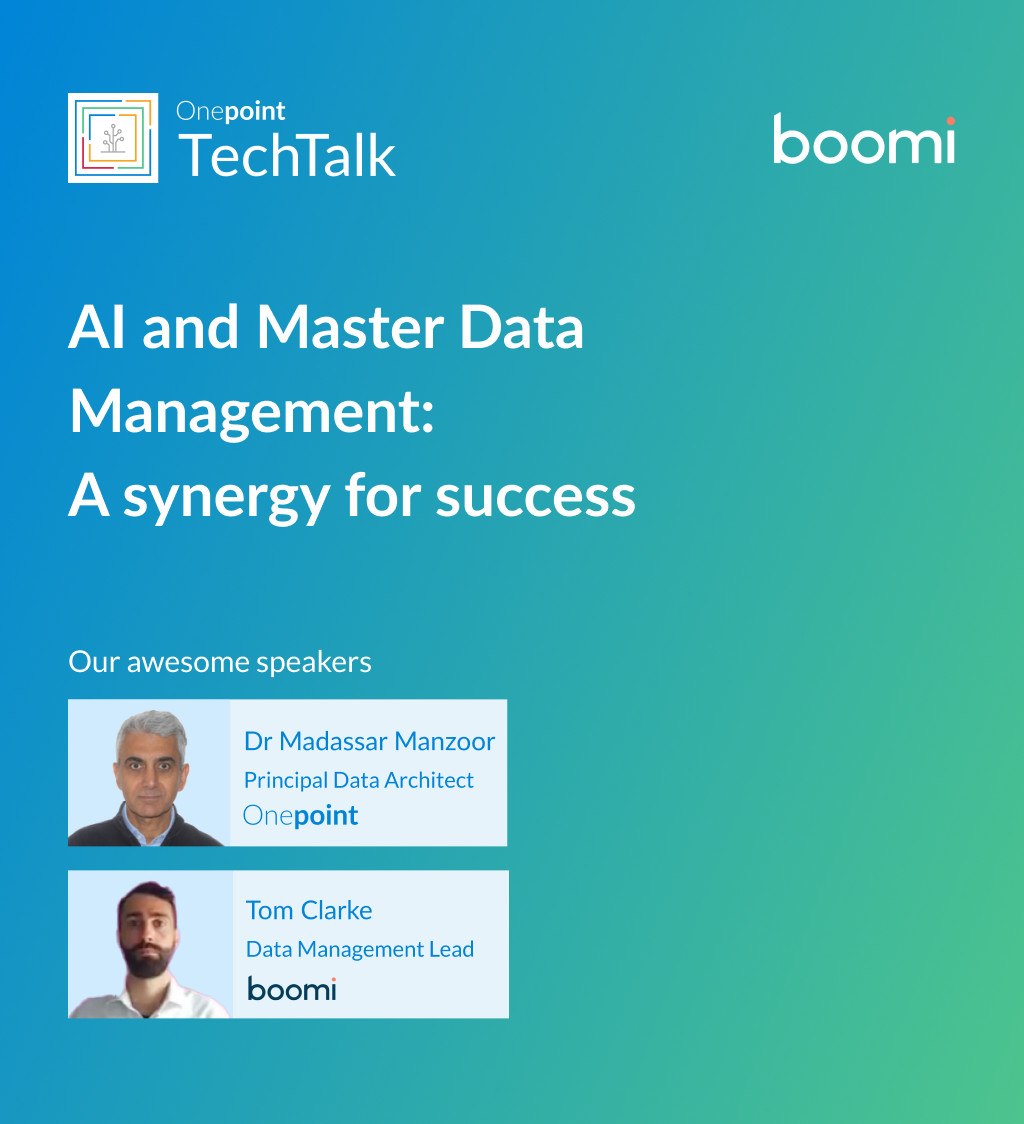
AI and Master Data Management: A synergy for success
Are you ready to maximise the impact of your AI initiatives? Join Boomi and Onepoint for an executive-level webinar exploring the critical intersection of AI and Master Data Management.
Decoding AI Series | Session 1
Fundamentals of Large Language Models
In this session we look at the fundamentals of Generative AI and Large Language Models (LLMs) — one of the most transformative AI technologies to emerge in recent years.
Unlocking the power of real-time data for digital transformation and AI decisioning
In partnership with Gigaspaces, join our panel of highly experienced digital transformation and data integration specialists who will provide you with invaluable insights and actionable solutions on how to unlock the power of real-time data for digital transformation and AI decisioning.
Coming soon
For more webinar replays, visit Onepoint TechTalk



